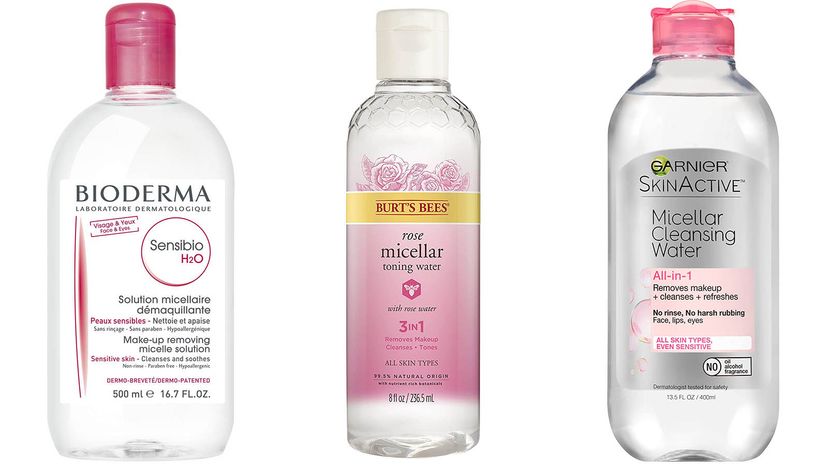\”

If you follow any type of beauty regimen, chances are you\’ve been hearing more and more about micellar water (pronounced mī-ˈse-lər). It\’s touted for its ability to effortlessly remove makeup, dirt and oil from the skin with just a couple swipes of a cotton ball — no water or cleanser — and leaving the skin clean and moisturized.
Once a well-kept secret among the French, micellar water has come out of obscurity in recent years and become one of the more talked-about beauty products among social media influencers.
What exactly is micellar water and where did it come from? Let\’s take a closer look.
Hard Water, Soft Sell
We have Paris\’ notoriously hard water to thank for micellar water. Hard water contains a lot of dissolved minerals like calcium and magnesium that strip away the skin\’s natural oils and can dry out and irritate skin.
As the story goes, French women became fed up with subjecting their faces to such harsh water. Enter Jean-Noël Thorel. The French pharmacist-biologist and founder of the Bioderma line of skincare products came to their rescue in 1991 with an invention he called micellar water.
For years after, the only way to get your hands on the product was to travel to France and buy it from a pharmacy. Like a lot of things that aren\’t readily available on the international market, micellar water became a much-praised and sought-after beauty product. It didn\’t even make its way to the U.K. until 2013. By the time it got to the States shortly thereafter, people were nipping at the bit to give it a try.
It didn\’t take long for competition to create their own formulations of Thorel\’s micellar water. These products are marketed under numerous brand names and sold online and at retail stores across the country from as little as $5 for Epielle Beauty to upward of $60 or more for big names like Yyves Saint Laurent.
So What Is Micellar Water?
"I first heard about micellar water was in 2015, when a client asked me about it," says Mindy Reese, a licensed medical aesthetician working in Nashville, Tennessee. "I have people ask me about products all the time. I have to research them because products come out so frequently."
What she read sounded innocent enough: Micellar water is not a facial toner, as one might think at first. Toners are designed to cleanse the skin and contain ingredients like alcohol, salicylic acid, witch hazel or glycolic acid. Micellar water, on the other hand, is much simpler. It contains purified water with tiny balls of cleansing oil called micelles. These balls act like little magnets, drawing oil, dirt and other impurities away from the skin. The product often contains other hydrating ingredients like glycerin or hyaluronic acid.
But don\’t be fooled by the term "water," Reese cautions. "It doesn\’t feel anything like water. It feels softer, almost slippery." It\’s also not intended to be splashed on the face like water. You simply soak a cotton ball or pad with the product and swipe it across your face and … that\’s it. No rinsing necessary. And, you don\’t really need moisturizer afterward because micellar water leaves your skin feeling moisturized, though some prefer to add it anyway.


It\’s Not for Everyone
With hard water not nearly as much of an issue in the United States as it is in Paris, it\’s the convenience factor that\’s winning over a lot of users. Micellar water is praised by models and fitness instructors who want to mop their faces quickly between activities, and people who travel frequently who don\’t have access to water to refresh before meetings.
Micellar water is promoted for all skin types, but Reese cautions against it for people with acne. (It made her acne-prone client break out.) "It leaves a film, a residue on the skin for hydration. So, if you\’re already acne prone, blackhead prone, have cystic acne or clogged pores, then that potentially could cause you to have breakouts," she says. "That\’s what it was doing to my client."
People who wear heavy makeup or waterproof mascara may also need to follow up with a separate cleanser or makeup remover. But for people with dry skin and small pores, micellar water should be fine, she says.
If you do use choose to use micellar water, Reese recommends not substituting it for every face washing. It\’s best to use it in the morning "because you are mostly bare faced," she says. "I wouldn\’t use it at night because I\’d be concerned that it wouldn\’t remove makeup completely."
Now That\’s Interesting
L\’Oréal-owned Garnier recently created a TikTok "rewind" challenge for its micellar water product and tapped influencers to promote the campaign using an original song the company created. Garnier sweetened the pot, offering $300 to up to 10 participants who tagged #MicellarRewind. The result? A staggering 3.2 billion views for a comparatively inexpensive advertising campaign.
















